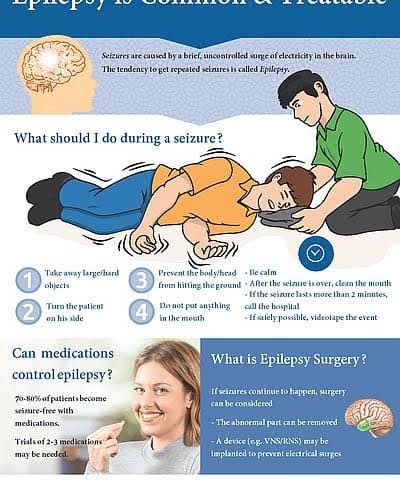
How to treat an epilepsy patient?
What is epilepsy??
It is a neurological condition that causes a temporary imbalance in electrical activity from time to time
Natural for the brain. Normal brain activity does not return until normal electrical activity stabilizes.
It is possible that the factors that lead to epilepsy are present from birth.
Or it may occur at a late age due to injuries, abnormal structures in the brain, or exposure to some toxic substances.
The difference between convulsion and epilepsy: Convulsion is a symptom of epilepsy, while epilepsy
It is the brain’s readiness to produce sudden charges of electrical energy that disrupt the functioning of other functions of the brain.
The occurrence of a single seizure in a person does not necessarily mean that this person suffers from epilepsy.
– High temperature, severe head injury, or deficiency
Oxygen and many other factors can trigger a single seizure
Epilepsy is a permanent disease or injury that affects sensitive organs and places
In the brain, which regulates the work and passage of electrical energy in different areas of the brain,
This results in an imbalance in electrical activity and repeated bouts of seizures.
How to treat epilepsy
Epilepsy is treated in several ways, the most important of which is treatment with anticonvulsant drugs, and rarely
We often resort to surgery as a treatment for recurrent epileptic seizures, and drug therapy is the first and primary option, as it can control the different forms of epilepsy.
Patients who suffer from more than one type of epilepsy may need to use more than one type of drug
In order for these anti-epileptic drugs to work, the treatment dose must reach a certain level in the blood in order to control the disease
This level in the blood must be maintained constantly, and therefore care must be taken to take the medication regularly and to fully adhere to the instructions of the treating physician, because the goal of treatment is to achieve control of the disease, while not causing any negative symptoms from taking these drugs, such as excessive sleep and other negative symptoms. .
The first aid that must be given to an epilepsy patient during a seizure
During major epileptic seizures, the paramedic must be calm when dealing with them.
– Protecting the patient’s head from hitting the ground or hitting something while moving during convulsions.
-Place the patient on his side so that his tongue does not fall back and block the respiratory tract.
– You should not try to forcefully stop seizures or prevent the patient from moving, unless there is a clear danger to his life.
– Avoid inserting any solid object between the teeth or into the patient’s mouth that may lead to his teeth being broken and swallowed.
– Do not give the patient any medications, food, or drink in the mouth of the injured person until after ensuring that the patient has completely regained consciousness.
If the seizure lasts more than five minutes or the patient remains unconscious, the doctor must be called immediately






